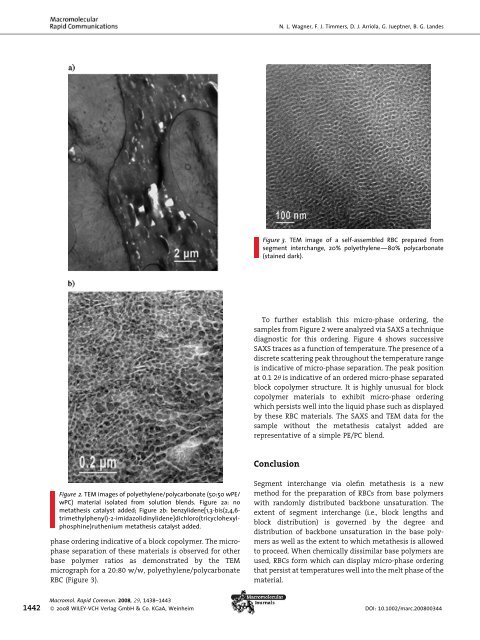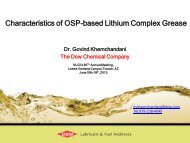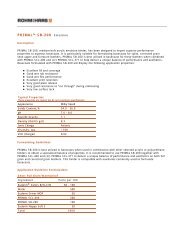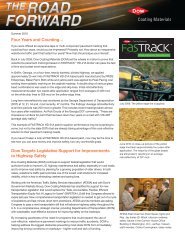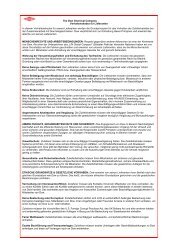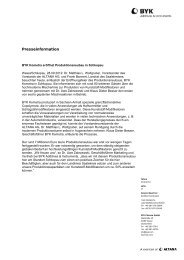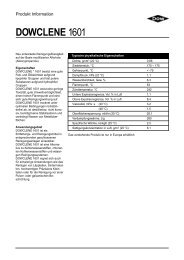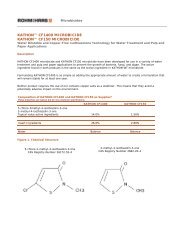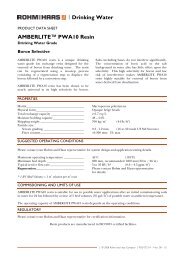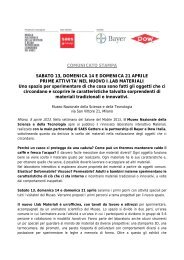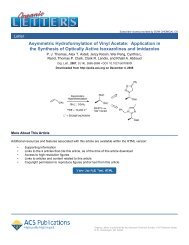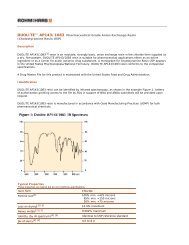Random Block Copolymers via Segment Interchange Olefin ...
Random Block Copolymers via Segment Interchange Olefin ...
Random Block Copolymers via Segment Interchange Olefin ...
You also want an ePaper? Increase the reach of your titles
YUMPU automatically turns print PDFs into web optimized ePapers that Google loves.
1442<br />
Figure 2. TEM images of polyethylene/polycarbonate (50:50 wPE/<br />
wPC) material isolated from solution blends. Figure 2a: no<br />
metathesis catalyst added; Figure 2b: benzylidene[1,3-bis(2,4,6trimethylphenyl)-2-imidazolidinylidene]dichloro(tricyclohexylphosphine)ruthenium<br />
metathesis catalyst added.<br />
phase ordering indicative of a block copolymer. The microphase<br />
separation of these materials is observed for other<br />
base polymer ratios as demonstrated by the TEM<br />
micrograph for a 20:80 w/w, polyethylene/polycarbonate<br />
RBC (Figure 3).<br />
To further establish this micro-phase ordering, the<br />
samples from Figure 2 were analyzed <strong>via</strong> SAXS a technique<br />
diagnostic for this ordering. Figure 4 shows successive<br />
SAXS traces as a function of temperature. The presence of a<br />
discrete scattering peak throughout the temperature range<br />
is indicative of micro-phase separation. The peak position<br />
at 0.1 2u is indicative of an ordered micro-phase separated<br />
block copolymer structure. It is highly unusual for block<br />
copolymer materials to exhibit micro-phase ordering<br />
which persists well into the liquid phase such as displayed<br />
by these RBC materials. The SAXS and TEM data for the<br />
sample without the metathesis catalyst added are<br />
representative of a simple PE/PC blend.<br />
Conclusion<br />
N. L. Wagner, F. J. Timmers, D. J. Arriola, G. Jueptner, B. G. Landes<br />
Figure 3. TEM image of a self-assembled RBC prepared from<br />
segment interchange, 20% polyethylene—80% polycarbonate<br />
(stained dark).<br />
<strong>Segment</strong> interchange <strong>via</strong> olefin metathesis is a new<br />
method for the preparation of RBCs from base polymers<br />
with randomly distributed backbone unsaturation. The<br />
extent of segment interchange (i.e., block lengths and<br />
block distribution) is governed by the degree and<br />
distribution of backbone unsaturation in the base polymers<br />
as well as the extent to which metathesis is allowed<br />
to proceed. When chemically dissimilar base polymers are<br />
used, RBCs form which can display micro-phase ordering<br />
that persist at temperatures well into the melt phase of the<br />
material.<br />
Macromol. Rapid Commun. 2008, 29, 1438–1443<br />
ß 2008 WILEY-VCH Verlag GmbH & Co. KGaA, Weinheim DOI: 10.1002/marc.200800344


